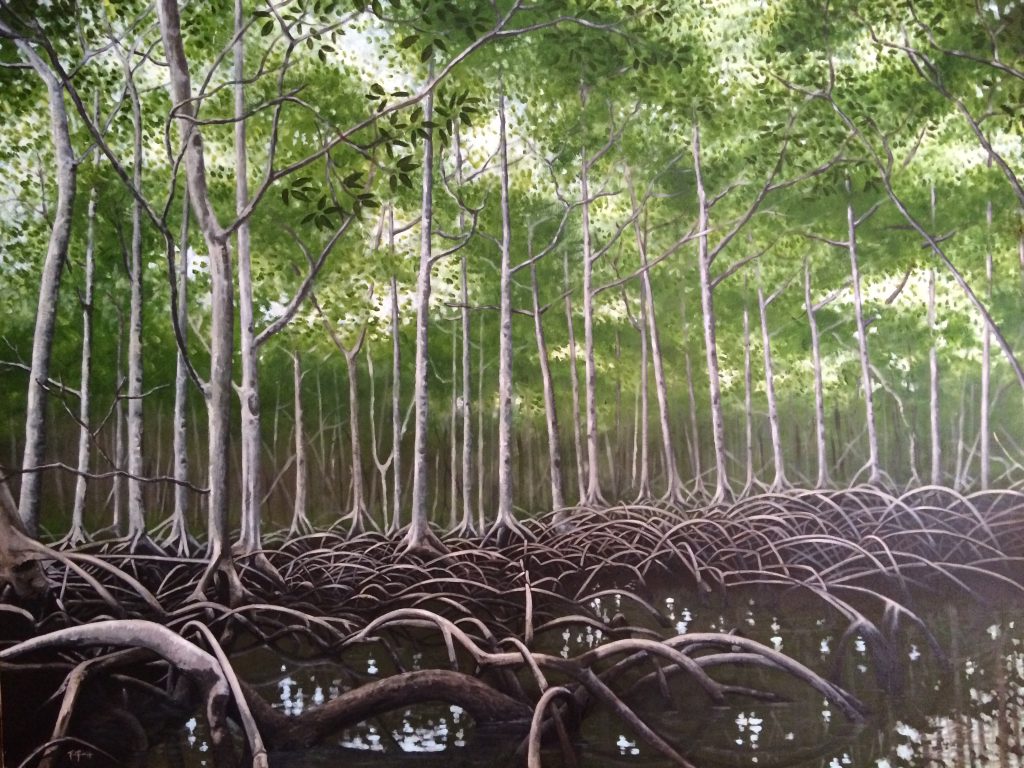Above: “Mangrove Plantation” by Paul Puckett
Whether fishing for tailing bonefish or cruising permit around small mangrove shoots, pushing deep into mangrove-lined creeks in pursuit of juvenile tarpon, or patiently staking out next to mangrove shorelines waiting for migrating tarpon, mangroves are an inextricable part of the flats fishing landscape. Yet we don’t often stop to contemplate the vitally important roles they play in so many aspects of coastal habitats, and the effects mangrove loss have on fish and their environments. Globally, more than half of mangroves have been lost, and continue to be lost at a rate of 1% per year, according to the Mangrove Action Project. The majority have been lost in the past 50 years and mostly in the last two decades. The main causes include shrimp farming, tourism, urbanization and agricultural expansion.
 To paraphrase Dr. Aaron Adams in The Fisherman’s Coast, mangroves serve important ecological roles in coastal environments. They provide important habitat for juvenile fish and invertebrates that use the habitats seasonally, and provide habitat for a whole group of fish and invertebrates that spend most of their life cycle in the mangrove ecosystem. They filter sediments from land that otherwise would smother coral and seagrass, and are important players in the nutrient cycles of coastal habitats. A recent article by Evelyn S. Gonzalez at Florida International University also notes the importance of mangroves in storing carbon—in Everglades National Park (home to the largest mangrove forests in the US), scientists have placed the value of that carbon storage at between $2 billion and $3.4 billion.
To paraphrase Dr. Aaron Adams in The Fisherman’s Coast, mangroves serve important ecological roles in coastal environments. They provide important habitat for juvenile fish and invertebrates that use the habitats seasonally, and provide habitat for a whole group of fish and invertebrates that spend most of their life cycle in the mangrove ecosystem. They filter sediments from land that otherwise would smother coral and seagrass, and are important players in the nutrient cycles of coastal habitats. A recent article by Evelyn S. Gonzalez at Florida International University also notes the importance of mangroves in storing carbon—in Everglades National Park (home to the largest mangrove forests in the US), scientists have placed the value of that carbon storage at between $2 billion and $3.4 billion.
“Although the Everglades National Park is a protected national treasure, the National Park Service doesn’t have much control over freshwater flowing into the park,” said Mahadev Bhat, co-author of the study and professor in the Department of Earth and Environment. “If there isn’t enough freshwater flowing through the Everglades, we may eventually lose some of the mangroves. And once you let stored carbon out, that same carbon can lead to increased global warming and cost society a lot more.”
In Everglades National Park, the key to helping protect these areas is to ensure freshwater flows to the Everglades are restored. In many other areas, it means considering the environmental impact (both in loss of carbon storage and critical habitat) of destroying mangroves for urbanization, shrimp farming and other projects, and advocating for the protection of important areas.
We all need to help raise awareness of the importance of mangroves and the threats to them if we want to see them around in the future. Our flats fisheries depend on them and without them, we can kiss those fisheries goodbye.




